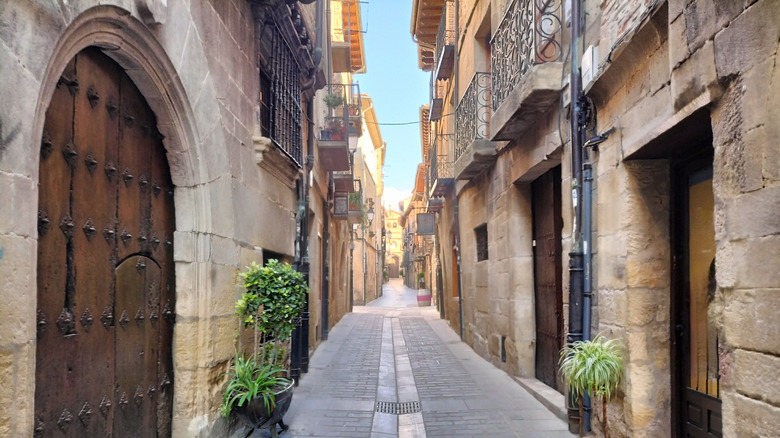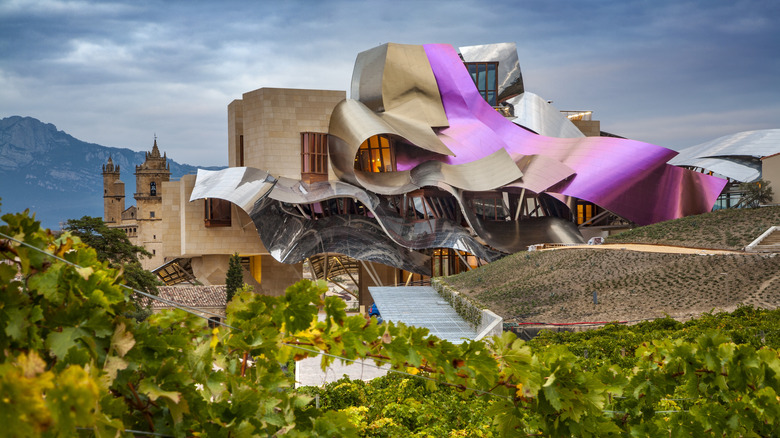Spain's Prime Wine Region Is A Rolling Tapestry Of Sandstone Villages And Legendary Cellars
Depending on the region you visit, a trip to Spain can include many different experiences. Sun, flamenco, and Moorish influence are ever present in the south, while paella is the star of Valencia on the eastern coast and can be found on nearly every corner. The Basque Country on Spain's northern coast is a hidden foodie paradise, as the proximity of the sea to the mountains creates a unique growing environment that enables chefs to produce some of the best cuisine in the world. However, to explore one of the country's most iconic libations, head to La Rioja — Spain's most well-known wine region, with over 500 wineries.
Lining the Ebro River, La Rioja extends over 60 diverse miles that include seven valleys with different microclimates that are divided among three main areas: Alta, Alavesa, and Oriental. While the capital of La Rioja is a town called Logroño with plenty of lodging options, there are more charming and unique places to make your home base, like the smaller villages of Elvillar, Elciego, and the fortified town of Laguardia.
The closest international airport to the region is in Bilbao, which is an easy one-hour drive from the bustling northern city. Alternatively, you could fly into Adolfo Suárez International Airport in Madrid and rent a car. Considering Spain is one of the best places in Europe for a road trip, the three-hour drive to La Rioja is a breeze. You could take a train, but to hop around from winery to winery and explore several of the villages at your leisure, a car is ideal.
Find your base among these medieval villages
If you had to choose one wine route to follow, the Rioja Alavesa is a great place to start exploring. With an intoxicating mix of oak forests, vineyards, streams, and ravines, the town of Elvillar is also home to several prehistoric archeological sites. Casa Robla is a winery and manor house from the 18th century that was lovingly restored and converted into an eco-chic boutique hotel. As the perfect base, you can easily drive from Elvillar to Laguardia to Elciego, in under 20 minutes.
The medieval walled town of Laguardia is a must-visit. The pedestrian-only village is home to Los Parajes, a unique property that features a restaurant, spa, wine bar, and an underground wine cellar whose caves were excavated in the 16th century. While initially used to store wine and food, and then as a shelter during times of war, the space is now a wine cellar to offer guests a tasting experience in a space that is over 500 years old. While in Laguardia, Villa Lucía is another unique spot to immerse yourself in the region's food and wine scene. There's a restaurant, a wine museum, and a 4D film experience to help you dive deep into the history and heritage of winemaking in Rioja Alavesa.
The town of Elciego is synonymous with the Marqués de Riscal hotel and winery (pictured). While the winery actually dates back to 1858, the hotel has a cutting-edge modern design that contrasts sharply with the rural backdrop. An interesting juxtaposition between the old and the new, the architecture is as modern as it gets. Designed by renowned architect Frank Gehry, who designed the Guggenheim Museum in Bilbao, the Marqués de Riscal Hotel opened in 2006, complete with a Caudalie spa guided by vinotherapy treatments.
Plan your wine tasting adventure through La Rioja
With over 500 wineries in the region, it can feel overwhelming trying to decide which ones to visit. Luckily, there are several options to streamline your experience and tailor it to your unique interests. The most obvious way to plot your course is to choose a specific route. Another way is to choose by theme, like wineries that are family-owned, modern, historical, and located on the vineyards or in the city. Oftentimes, several may even overlap.
In La Rioja, you will find reds, whites, rosés, and sparkling wines. For reds, the most common grapes are tempranillo and garnacha (which are also grown in Spain's lesser-known Priorat region). When tasting, a crianza is the youngest wine, aged less than two years, while a reserva is aged for at least three years, at least one of which is in barrels. A gran reserva, aged over five years, tends to acquire more body and complexity (and a higher price point) since it needs at least two years of aging in oak casks. Common white wines from La Rioja are viura and verdejo, both of which are crisp and pleasant on a warm Spanish day.
In addition to Marqués de Riscal (pictured), there are other specific wineries to seek out, including the family-owned Finca Valpiedra. The B Corp Baigorri, which makes a very drinkable crianza, is focused on a circular economy, reusing grape stems for innovative animal feed, reducing overall waste. Bodegas Ysios is a sustainable and regeneratively farmed vineyard. The building's architecture is another stunning sight to behold, as the design is meant to mimic the Cantabrian mountains in the backdrop.


